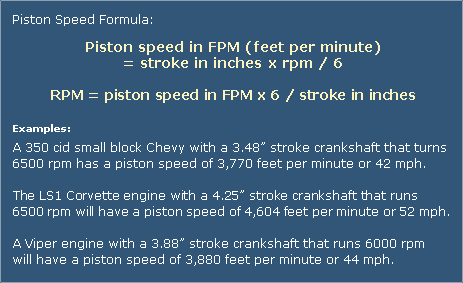 |
 |
 |
| THE READ FOR SPEED by Ned Erkman |
| CHAPTER 6 |
 |

Piston Speed - Crankshaft Stroke
The rate of speed that the piston travels up and down in the cylinder wall is referred to as the piston speed. The piston speed is determined by the crankshaft stroke and the engine rpm.
Piston speed is important to understand when the stroke of an engine is being increased. Since a faster piston speed occurs with a larger stroke more durable engine components may be necessary for the increased stress on the pistons and rods.
The faster rate of piston speed will also result in a piston that travels quicker during the combustion cycle with less dwell time during spark ignition. A very high piston speed can cause the piston to move faster than the flame front during the combustion process resulting in a reduction of power.

The size of the crankshaft stroke also affects engine acceleration as a longer stroke makes the piston travel more distance to complete a full revolution.
The difference in piston speed can be measured in feet per minute between different size stroke crankshafts. For example, a 3.75 inch stroke crankshaft has a piston speed of 4,375 feet per minute and a 4.25 inch stroke crankshaft has piston speed of 4,958 feet per minute. This means the piston for the longer stroke crank travels more distance, specifically 583 feet more per minute or 9.72 feet more per second. Another method for a comparative analyzes is to consider the ½ inch longer stroke of the 4.25 inch crankshaft requires the piston to travel 1 full inch more per revolution by traveling ½ inch lower and another ½ inch higher to complete a full revolution of the crankshaft. The longer stroke crank travels 7000 inches more distance at 7000 rpm or 9.72 feet more distance per second. (7000 inches /12 = 583 ft per minute & 583 ft / 60 = 9.72 per sec)
This also means a 4.25 stroke crankshaft, with the same piston speed as the 3.75 stroke crank, rotates at a slower speed. The slower crankshaft rotation results in a slower rate of engine acceleration, which results in a slower rate of vehicle acceleration.
These are some of the factors that make crankshaft stroke an important component for engine acceleration. These examples can also help to explain why some big stroke engines make more power on a dyno and run slower at the track than a less powerful engine that can accelerate faster.
Dyno tests that are performed at slower rates of engine acceleration can produce more power as it is easier to cylinder fill with a slower increase in engine rpm and when the same engine is required to accelerate faster on the same dyno it can produce less power. A higher rate of engine acceleration also affects power production as producing power becomes more difficult when the engine rpm changes. This means that a steady state dyno test with little or no rpm increase will make more power than a dyno test with a rapid rate of engine acceleration, since it is more difficult to generate power when the engine rpm is increasing. A rapid rate of engine acceleration requires better cylinder filling capability through the cylinder heads and intake manifold in order to deliver more airflow as the required airflow rate increases with engine rpm.
Dyno tests with acceleration rates that are similar to the acceleration rate of the engine under real world driving conditions can provide more realistic power output results and more accurate vehicle performance expectations.
These are some examples of why engine stroke, piston speed and engine acceleration are very important for performance.
Ned Erkman
Author of The Read for Speed
Copyright © 2005 The Read For Speed. All Rights Reserved.
Reproduction in whole or in part without expressed written permission from the author
is strictly prohibited.
|
 |
|
 |
|
 |







